1 引 言
现今青藏高原的形成是新生代以来印度—欧亚大陆持续挤压碰撞的结果[1~5],在这一挤压过程中,产生了一系列南北走向裂谷以及班公湖—怒江缝合带两侧的共轭走滑断层(图1),这些构造导致高原内部发生了大规模东西向伸展[10~19]。这些伸展构造不仅被发现于拉萨和羌塘地体,在雅鲁藏布江缝合带以南的喜马拉雅也有广泛分布(图1)。20世纪70年代,地质学家首先通过Landsat卫星影像和地震学证据,确定了青藏高原内部的活动构造以东西向伸展和走滑为主,进而确定了南北走向裂谷的广泛分布[10];80年代开始,中法联合考察对南北走向裂谷进行了大量定量化工作[11,20~22];此后数十年间,国内外学者从构造地质学、地质年代学、沉积学以及地震学等不同角度对其进行了大量理论和实验研究[16,23~26],提出了大量有关南北走向裂谷形成模式和演化过程的模型[27~29]。
图1
图1
青藏高原南北走向裂谷分布、初始拉张时间及主要构造活动速率(据参考文献[6, 7]修改)
黑色圆数字代表南北走向裂谷编号,1:Leo Pargil,2:Gular Mandhata,3:隆格尔,4:Thakkola,5:当惹雍错—孔错,6:申扎—定结,7:亚东—谷露,8:沃卡—错那,9:双湖;编号旁红色斜体数字(单位:Ma)代表裂谷初始拉张时间;蓝色数字代表主要构造活动速率(单位:mm/a)[8,9]
Fig.1
Distribution, onset timing of N-S striking rifts and slip rates of main structures in Tibet (modified after references [6,7])
The black round numbers represent N-S striking rifts, 1: Leo Pargil, 2: Gular Mandhata, 3: Lunggar, 4: Thakkola, 5: Tangra Yum Co-Kong Co, 6: Xainza-Dinggye, 7: Yadong-Gulu, 8: Woka-Cuona, 9: Shuanghu; The red italic numbers in Ma next to these numbers represent onset timing of E-W extension; Blue numbers represent slip rates of main structures (unit:mm/a)[8,9]
近年来,应用岩石地球化学和地球物理探测等手段,对青藏高原的深部构造和圈层结构有了更新且更全面的认识和了解[30~33],也将南北走向裂谷的形成机制与高原深部动力学过程有机的结合起来[29,31]。尽管如此,研究者对于青藏高原南北走向裂谷的认识仍难以达成共识。现今发现的青藏高原南北走向裂谷有的表现为高角度特征,而另一些则为低角度拆离断层[34]。通常,这两种不同类型的正断层在活动速率、总伸展量、地貌演化和盆地演化等方面有明显不同。控制青藏高原南北走向裂谷构造样式和伸展幅度的因素包括地壳和地幔岩石圈的热状态、上下地壳的强度差异以及由古老变形继承而来的构造特征[35]。因此,高角度和低角度正断层的同时出现表明青藏高原内部地壳和地幔岩石圈的力学特征存在明显的空间差异。
为了更好地理解印度—欧亚碰撞背景下的东西向伸展构造特征,其关键在于南北走向裂谷拉张时间的厘定和活动速率的定量化约束。国外研究团队较早地对青藏高原东西向伸展时间进行了定量化约束[24,36],大部分学者认为高原内部的裂谷形成于中新世中期至晚期[24,37,38]。尽管与裂谷相关的岩浆活动将其拉张时间向前推移至中新世早期[39,40]甚至始新世[41],但高原主要的东西向伸展时间似乎仍然为中新世中期以后。另外,青藏高原东西向拉张与南北向拉张的启动时间是否一致,直接关系到两者是两个不同的构造事件还是同一构造事件的不同响应[40]。关于南北走向裂谷活动速率的研究集中于第四纪和雅鲁藏布江缝合带以南[23,42],新近纪的活动速率研究很少[34],严重制约了对南北走向裂谷时空演化的认识。
本文对近年来青藏高原内南北走向裂谷的分布特征、启动时间、成因模式以及其与高原深部圈层之间的关系等问题的研究现状和存在问题进行了综述,探讨了现阶段对高原内南北走向裂谷的认识及制约因素,以期读者对青藏高原南北走向裂谷研究的进展和发展趋势有进一步的了解,并对关键科学问题进行深入研究。
2 青藏高原南北走向裂谷分布及性质
尽管青藏高原近南北走向裂谷南北跨度极大,但以班公湖—怒江缝合带为界,裂谷带在其两侧表现为不同分布特征[11]。缝合带以北的裂谷带分布相对集中,南北延伸距离较短,单条裂谷最小间距仅50 km,单个裂谷内垂直位错较小,走向偏北东向(图1),并且其形成及分布与靠近缝合带北侧的左旋走滑断裂相关[13,20,29]。在缝合带以南的拉萨地体内则表现为7条大型南北走向裂谷带,自西向东依次为Leo Pargil、隆格尔、打加错—Thakkola、当惹雍错—孔错、申扎—定结、亚东—谷露和沃卡—错那裂谷带(图1)。各裂谷带间距基本一致,垂向位错较大,南北延伸距离较远,其走向以87°E为界,以西表现为NNW向,以东表现为NNE向。仅从南北走向裂谷的分布特征来看,拉萨及喜马拉雅地体的东西向伸展作用较强。有趣的是,青藏高原的南北走向裂谷近似以87°E为轴发散(图1),这一方向与印度—欧亚大陆汇聚的方向近似平行,表明由陆陆碰撞产生的应力场对南北走向裂谷的发育有重要作用[14]。
根据南北走向裂谷的空间分布特征,高原内部东西向拉张作用主要集中于拉萨地体和喜马拉雅地体(图1)[10,43]。各裂谷带初始拉张时间及活动速率如表1所列。由于印度板块汇聚方向近似与喜马拉雅弧相垂直,估算得到其缩短速率约为20 mm/a,这一速率在空间上与藏南东西向拉张速率(10 mm/a)相匹配[11,67],也与现今GPS数据观测的伸展速率(13~15 mm/a)相一致[42,49,68]。然而,各个南北走向裂谷带的伸展速率存在一定差异:如申扎—定结裂谷带的伸展速率仅为1~2 mm/a,而隆格尔、当惹雍错和亚东—谷露裂谷带的伸展速率则达到4~5 mm/a[49](图1)。不同裂谷带东西向伸展速率的差异表明其运动学特征、断层性质和深部岩石圈构造可能存在不均一性。
表1 青藏高原南北走向裂谷初始拉张时间
Table 1
| 裂谷名称 | 拉张时间/Ma | 测年方法 | 流变学特征 | 活动速率/ (mm/a) | 参考文献 | |
|---|---|---|---|---|---|---|
| 羌塘地体 | 双湖 | 13.5 4 | 40Ar/39Ar 地形剖面 | 脆性 | - | [44] [45] |
| 与东西向伸展相关的埃达克岩 | 47~38 | U-Pb,同位素地球化学 | 岩脉 | - | [41,46,47,48] | |
| 拉萨地体 | 隆格尔 | >10 | (U-Th)/He | 韧性 | 4.0~5.0[49] | [50] |
| 打加错 | 18.3 | U-Pb | 岩脉 | - | [39] | |
| 当惹雍错 | 约13 14.5 | (U-Th)/He (U-Th)/He, AFT | 脆性 | 0.3~0.7[34] 4.0~5.0[49] | [51] [34] | |
| 申扎 | 约14 | U-Pb | 脆性 | 1.0~2.0[49] | [52] | |
| 念青唐古拉 | 11~5 8 | 40Ar-39Ar Th-Pb | 韧性—脆性 | 4.0[24] | [27] [24] | |
| 谷露 | 7 | (U-Th)/He | 脆性 | 4.0~5.0[49] | [53] | |
| 喜马拉雅 | Leo Pargil | 16.9~14.5 | 40Ar/39Ar | 韧性 | - | [54,55] |
| Gular Mandhata | 15~9 | 40Ar/39Ar | 韧性 | - | [56] | |
| Thakkola | 11~10 | 磁性地层 | - | - | [57] | |
| 孔错 | 19 13~12 4 | U-Pb (U-Th)/He U-Pb, Ar/Ar, (U-Th)/He | 韧性—脆性 | - | [40] [58] [59] | |
| Ama Drime Massif | 13 | Th-Pb | 韧性—脆性 | 0.6~1.7[60] | [53] | |
| 4 | (U-Th)/He | [61] | ||||
| 11 | P-T-D-t | [62] | ||||
| 亚东 | <10 | Th-Pb | - | 1.4[11] | [63] | |
| 5 | 40Ar/39Ar | 脆性 | [64] | |||
| 错那 | <12 | K/Ar | - | 0.6~1.7[65] | [66] | |
从控制南北走向裂谷边界的断层性质来说,青藏高原内部南北走向裂谷带大部分以高角度(倾角多为40°~60°)正断层为界,仅隆格尔裂谷带和亚东—谷露裂谷带中部的边界断裂为低角度正断层或拆离断层(倾角小于30°)[69~72]。随着技术手段的进步、数据的增加和分析能力的加强,对限定裂谷带的正断层的性质认识也在不断提升。例如申扎—定结裂谷带先前被认为以低角度正断层为界[73],然而,该裂谷带内最新地震的地震波、断层参数和InSAR数据似乎不支持上述观点。当然,不能排除边界断裂性质在不同时间段内发生转变,也不能忽视地表断裂在深部具有不同几何形态[74]。高角度和低角度正断层的同时出现表明高原内部地壳和地幔岩石圈的力学特征存在明显的空间差异,这种差异的控制因素及影响尚未进行深入研究。
3 南北走向裂谷拉张时间
藏南念青唐古拉山地区是研究南北走向裂谷拉张时间的窗口,正断层下盘岩体的40Ar-39Ar和磷灰石裂变径迹年龄揭示该区域在11~5 Ma经历了快速剥露[27],该阶段的快速剥露被解释为由南北走向裂谷的活动引发,这是最早有关南北走向裂谷的精确年龄测定。后续更精确的年代学工作将念青唐古拉山南北走向裂谷的拉张时间限定为8 Ma,并提出青藏高原此时已经达到最大高度[12,24],这些研究为此后Molnar等[36]提出对流移除模型提供了非常坚实的年代学基础。随着测年手段的进步,藏北双湖(13.5 Ma)[44]、藏南孔错(12~13 Ma)[58]、Thakkola盆地(14 Ma)[57]、申扎裂谷(14 Ma)[52]及当惹雍错裂谷(15~13 Ma)[34,51]等裂谷带的拉张时间相继被报道(表1);其中,最直接的初始拉张时间约束来源于拉萨地体羊八井裂谷带的低温热年代学年龄(8~4 Ma)[12,53]。同时,这一时限也与区域性重要地质事件的时代相吻合,如南亚季风加强[75,76]和海洋上升流[77]等,表明高原大规模隆升发生于晚中新世。此外,沉积学和磁性地层学研究显示,藏南几个与南北走向裂谷相关的沉积盆地在10.6~8.1 Ma时开始接受沉积[25,78~80],这在时间上与热年代学方法大致吻合。另外,钾质超钾质岩的年龄对南北走向裂谷的拉张时间能够提供间接约束[81,82]。这些研究基本上认为南北走向裂谷的拉张时间为中新世中晚期。
中晚中新世的裂谷拉张时间不断受到挑战。通过推算主边界断裂上产生总滑动量所需的时间,双湖地堑的伸展开始时间被限定为4 Ma[45];而与南北走向裂谷相关的岩浆岩的定年结果显示其时代最早可达(18.3 ± 2.7) Ma[39]和(19.06 ± 0.15) Ma[40],南北走向裂谷初始拉张时间可能提前到早中新世。近年来,对藏北羌塘地区与南北走向裂谷相关的埃达克质岩石定年结果表明,与之相关的藏北拆沉以及伸展作用可能在始新世就已经开始,因此南北走向裂谷的拉张时间可能追溯到始新世[41,46~48]。总的来说,关于东西向伸展构造的年龄大致可分为4种不同的观点:晚中新世后(8~4 Ma)、中晚中新世(15~8 Ma)、早中新世(>16 Ma)和始新世(47~38 Ma)(表1)。南北走向裂谷拉张时间时空差异的控制因素是什么,其启动时间是否存在空间规律,以及其活动是否具有多期次特征,这些问题亟待解决并且关乎对其成因模式的认识。
另外,由于对裂谷拉张时间的限定来自不同测年手段,需要对其可靠性和局限性进行评估。综合前人研究成果,目前获得裂谷拉张时间的技术手段主要有三大类。第一类是与东西向拉张有关的岩浆岩。东西向拉张背景下形成的岩浆岩通常以岩脉的形式产出,岩浆岩形成于地壳深部,其形成时间可能早于裂谷拉张时间,因此根据岩浆岩的年龄获得的裂谷拉张时间较老[39],在羌塘地体内甚至获得了始新世年龄[41]。由于裂谷拉张与岩浆作用之间是否存在因果关系尚存在较大争论,因此通过该方式获得的年龄应慎重评估。第二类是低温热年代学测年。该方法被广泛应用于裂谷拉张时间、期次和活动速率的定量研究(表1),是目前较为可靠的测年方式。目前应用较为广泛的是低温热年代学测年,包括磷灰石(U-Th)/He(AHe)、磷灰石裂变径迹(AFT)、锆石(U-Th)/He(ZHe)、锆石裂变径迹(ZFT)和40Ar/39Ar法等。低温热年代学本质上反映的是岩体的冷却年龄,尤其在岩浆活动频繁和剧烈的地区应用此方法应注意区分热扩散和构造作用。另外,由于高原内部新生代构造活跃,热年代学可能记录了整体构造抬升事件,而非裂谷拉张过程,因此在解释低温热年代学年龄时应十分谨慎[83]。第三类是沉积地层约束。沉积地层的约束主要来自早期沉积物的磁性地层年龄限制。理论上,沉积地层要滞后于裂谷拉张,因而其年龄能够约束裂谷活动的下限年龄,此外,磁性地层的多解性对于该方法的应用具有一定影响[79]。综上所述,低温热年代学测年是目前较为可靠且应用最广泛的约束手段。由于各种约束方法都存在一定局限性,因此在对裂谷拉张时间的限定上应谨慎评估,力争多角度多方法形成可靠的证据链。
4 南北走向裂谷成因模式
图2
重力垮塌模式是最早由Molnar等[10]提出的与青藏高原南北走向裂谷相关的高原生长模型,该模式强调了高原内部由于达到了均衡极限而发生了均一变形,变形开始时间和强度在整个高原内都是统一的(图2f)。随后,England等[30]通过模拟实验证明,只有青藏高原岩石圈底部发生整体对流移除才可能导致高原从挤压应力向伸展应力转变,从而触发大规模南北走向裂谷活动。后续,Molnar等[36]认为单独的均衡反弹引起的慢速隆升并不能触发如此大规模的南北走向裂谷产生,其根据南北走向裂谷的启动时间[念青唐古拉山(8±3) Ma]限定青藏高原岩石圈发生大规模对流移除的时间,并首次提出南北走向裂谷的出现代表青藏高原海拔达到最大高度,将南北走向裂谷与高原隆升剥露历史有机的结合起来。而离散块体变形模式(图2g)则强调了高原内部变形的不均一性。
如前所述,青藏高原南北走向裂谷与深部构造息息相关,这就将南北走向裂谷的形成机制及时代与高原深部的动力学过程有机结合起来。印度岩石圈板片撕裂模型[29](图3)提出后,根据埃达克质岩石与钾质超钾质岩石以及相关矿床与南北走向裂谷的分布位置进一步完善了板片撕裂模型,即板片发生垂直于碰撞方向的撕裂使得软流圈物质大量上涌,导致下地壳物质部分融熔,而下地壳部分融熔物质(埃达克质熔浆)和软流圈地幔(超钾质熔浆)沿着耦合板片撕裂的上覆裂谷带上涌[31, 95~97]。这样的模型得到了地球物理数据的进一步支持。高原东西向地球物理截面上存在壳幔边界不一致的现象,据此提出由于印度板片俯冲角度发生变化导致板片撕裂形成窗口,地幔沿这些窗口上涌导致岩石圈形变,形成亚东—谷露和念青唐古拉山等裂谷带[93, 98, 99]。尽管该模型的细节,如板片撕裂块数、撕裂板片的俯冲角度(图3)等存在争论,这些研究成果为南北走向裂谷的成因机制研究提供了全新视角。
图3
图3
南北走向裂谷板片撕裂模型(据参考文献[93, 94]修改)
(a)印度岩石圈板片撕裂为不同的角度;(b)印度岩石圈板片撕裂角度东西两侧较缓,中部较陡;MBT:主边界断裂;MFT:主前锋断裂;MCT:主中央断裂;STDS:藏南拆离系;ZRT:泽当—仁布断裂;IYS:雅鲁藏布江缝合带;YRR:亚热裂谷带;LGR:隆格尔裂谷带;TYR:当惹雍错裂谷带;PXR:申扎裂谷带;YGR:亚东—谷露裂谷带;CR:错那裂谷带
Fig.3
Slab tearing model for the formation of N-S striking rifts (modified after references [93, 94])
(a) Slab tearing of the Indian lithosphere shows differential subduction angles; (b) Slab tearing of the Indian lithosphere shows shallow angles in the east and west and deep angles in the middle;MBT: Main Boundary Thrust; MFT: Main Frontal Thrust; MCT: Main Central Thrust; STDS: Southern Tibetan Detachment Systems; ZRT: Zedong-Renbu Thrust; IYS: Indus-Yarlung Suture; YRR: Yari Rift; LGR: Lunggar Rift; TYR: Tangra Yum Co Rift; PXR: Pumqu-Xianza Rift; YGR: Yadong-Gulu Rift; CR: Cuona Rift
目前关于南北走向裂谷的成因模式依然争论不休,如此大规模的东西向伸展势必有深部过程的控制,因此对于高原深部过程的研究是解析裂谷成因的关键。随着对南北走向裂谷的进一步研究,研究者们发现南北走向裂谷的拉张时间贯穿整个晚新生代,有些南北走向裂谷的拉张时间甚至可以追溯到始新世[41]。GPS和ESR定年数据表明,一些南北走向裂谷甚至在第四纪还存在剧烈活动[11]。这些研究均表明,南北走向裂谷成因模式较为复杂,并不是某种单一的地球动力学因素控制南北走向裂谷的形成,其成因具有多阶段性和多因素特点。例如,早期南北走向裂谷的活动可能与重力垮塌相关,而晚期则与印度板片俯冲相关[28];或者下地壳流与印度板片下插共同触发了南北走向裂谷的形成[58,100]等。
5 高导低速体与南北走向裂谷的关系
地球物理学是近几十年来新兴发展的用于探测深部岩石圈结构和构造的手段。对于青藏高原及其邻区的岩石圈深部结构研究,最早由赵文津院士及美国科学家主导的INDEPTH(International/Interdisciplinary Deep Profiling of Tibet and Himalaya)计划开始,后续不同研究者获得了大量的地球物理数据[101~108]。这些地球物理数据显示高原内部地壳普遍存在地球物理异常的软弱层,并且这些软弱层沿东西方向在不同地区的规模、埋深以及地球物理特性等方面都存在局部差异,这种差异可能与上地壳伸展作用和岩石圈地幔的俯冲特征密切相关[32]。而大量数据表明,在大型南北走向裂谷附近地球物理数据异常,大多存在着高导低速体(图3b,图4)。
图4
图4
青藏高原低速带平面分布(a)及其东西向横剖面(b)(据参考文献[94]修改)
JS:金沙江缝合带;BNS:班公湖—怒江缝合带;IYS:雅鲁藏布江缝合带;YRR:亚热裂谷带;LGR:隆格尔裂谷带;TYR:当惹雍错裂谷带;PXR:申扎裂谷带;YGR:亚东—谷露裂谷带;CR:错那裂谷带
Fig.4
Distribution of low-velocity areas in Tibet (a) and longitudinal cross section (b) (modified after reference [94])
JS: Jinsha Suture; BNS: Bangong-Nujiang Suture; IYS: Indus-Yarlung Suture; YRR: Yari Rift; LGR: Lunggar Rift; TYR: Tangra Yum Co Rift; PXR: Pumqu-Xianza Rift; YGR: Yadong-Gulu Rift; CR: Cuona Rift
6 南北走向裂谷与钾质超钾质岩石、埃达克质岩石的成因联系
与青藏高原南北走向裂谷相联系的另一深部圈层产物为埃达克质岩石和钾质超钾质岩石。埃达克质岩石和钾质超钾质岩石作为岩石圈增厚和软流圈地幔上涌的产物,代表了深部岩石圈演化阶段的不同事件。埃达克质岩石和钾质超钾质岩石的岩石年龄为8~25 Ma[48,97,110~116],并且这些岩石在野外产出的构造背景上,显示了与南北走向裂谷、南北向延长的湖泊及新生代沉积盆地分布的密切关系[81](图5)。显然,简单的岩石圈拆沉以及地幔整体加厚导致对流减薄模型都无法完美解释后碰撞岩浆岩与南北走向裂谷的时空分布特征。埃达克质岩石和钾质超钾质岩石与南北走向裂谷发育及岩脉侵入等构造—岩浆事件的时空重叠具有内在成因联系,暗示着可能存在深部岩石圈演化的统一事件[81]。
图5
图5
青藏高原南北走向裂谷与相关岩浆岩分布关系
1:Leo Pargil;2:Gular Mandhata;3:隆格尔;4:Thakkola;5:当惹雍错—孔错;6:申扎—定结;7:亚东—谷露;8:沃卡—错那;9:双湖;ALT:阿尔金断裂;KF:昆仑断裂;KLF:喀喇昆仑断裂;JF:嘉丽断裂;JS:金沙江缝合带;BNS:班公湖—怒江缝合带;IYS:雅鲁藏布江缝合带
Fig. 5
Distribution of N-S striking rifts and related magmatic rocks in Tibet
1: Leo Pargil; 2: Gular Mandhata; 3: Lunggar; 4: Thakkola; 5: Tangra Yum Co-Kong Co; 6: Xainza-Dinggye; 7: Yadong-Gulu; 8: Woka-Cuona; 9: Shuanghu: ALT: Altyn Tagh Fault; KF: Kunlun Fault; KLF: Karakoram Fault; JF: Jiali Fault; JS: Jinsha Suture; BNS: Bangong-Nujiang Suture; IYS: Indus-Yarlung Suture
Turner等[37,82]国外学者20世纪90年代通过系统分析对比藏南与藏北中新世钾质和超钾质岩石的40Ar-39Ar年龄和地球化学特征,将其形成机制与岩石圈地幔对流减薄相联系。同时,由于南北走向裂谷与藏南地区钾质超钾质岩石具有时空上的相似性,因此其将岩石圈对流减薄与高海拔和快速剥露联系起来,认为由于岩石圈减薄触发南北走向裂谷的产生和后碰撞超钾质岩石的形成[82]。埃达克质岩石与钾质超钾质岩石以及相关矿床与南北走向裂谷的分布位置也是板片撕裂模型被提出和不断完善的重要依据[29, 31, 97]。板片撕裂模型能较好地解释拉萨地体钾质超钾质岩石与埃达克质岩石呈南北向带状展布的空间分布特征,然而却无法解释南北走向裂谷在进入羌塘地体后方向变为NNE[117]以及在高原北部存在大量上新世到第四纪的埃达克质岩石[118]。而且羌塘地体内中新世钾质超钾质岩石和埃达克质岩石的分布与南北走向裂谷并未显示明显的对应关系(图5),这对两者之间的耦合理论提出了挑战。
同样,近年来的研究表明,南北走向裂谷与印度—欧亚碰撞后的岩浆活动均受控于深部动力学过程,二者之间并无因果关联。加厚岩石圈地幔的底部发生了对流减薄及拆沉作用,导致软流圈上涌形成了幔源超钾质岩石,而加厚的下地壳则形成了埃达克质岩石[119]。此外,这一过程可能造成高原内部在中新世发生快速隆升,并在拉萨地体内发育了系列近南北走向的裂谷。
7 南北走向裂谷相关沉积作用
伴随着高原内部东西向拉张作用,形成了一系列晚新生代沉积盆地,如错那盆地、Thakkola盆地、帕里盆地等。这些盆地大多发育了较为完整的新生代地层,这些地层的时代和沉积过程对于青藏高原南北走向裂谷的拉张时间和拉张机制具有重要意义。例如,对Thakkola半地堑盆地内沉积地层的古地磁研究表明,其裂谷拉张时间为11~10 Ma[57];对错那裂谷中段的沉积地层ESR定年结果揭示早期沉积时代大于5 Ma,其裂谷初始拉张时代为10~5 Ma[80];对藏南一系列裂谷盆地的磁性地层梳理结果显示,藏南南北走向裂谷的初始拉张时间为10.6~8.1 Ma[79]。然而,由于地层出露等原因,高原中部裂谷内沉积地层的研究程度相对较低。以当惹雍错裂谷盆地为例,盆地两侧山脉的强剥蚀表明,在当惹雍错裂谷拉张时期(15~12 Ma),裂谷内应有大量沉积物堆积,理论上裂谷盆地内应保存中中新世至现今的连续沉积记录,而目前只对晚第四纪的湖相沉积物进行了研究,因此湖盆内的中新世沉积物对于裂谷的形成和气候变化等关键科学问题具有重要指示意义,但需要钻探技术的辅助[34]。由此可见,与裂谷相关的沉积物具有广阔的研究前景。
盆地形成机制方面,其演化受伸展构造的演变过程控制(图6)[70]。受高角度正断层控制的裂谷盆地被认为是“不成熟”的盆地,其沉积特征表现为内流湖盆(图6a)[121]。控制“不成熟”盆地的高角度正断层往往位移量较小(小于几公里),且大部分高角度正断层现今仍然活动,如申扎裂谷[73]。“不成熟”裂谷沉积中心位于盆地中心,且至今仍在接受沉积,因此早期沉积记录无法出露,如当惹雍错半地堑[34]。相反,“成熟”裂谷盆地受低角度正断层控制,断层位移量通常大于10 km,并且断层上盘正经历快速抬升和剥蚀,盆地内沉积特征表现为盆地中部存在分水岭,沉积中心位于分水岭两侧,为外流盆地(图6c)[121]。典型的“成熟”裂谷包括拉萨地体西部的隆格尔裂谷和东部的念青唐古拉裂谷。前者的沉积序列表现为湖盆向碎屑流控制的冲积扇(图6b)转变,最终演化为轴向河流沉积体系;后者在盆地中部存在明显分水岭,沉积物向北输入当雄盆地,向南输入羊八井(图6c)。
图6
图6
青藏高原裂谷盆地演化过程(据参考文献[70]修改)
(a)裂谷初期为内流半地堑盆地,受犁式高角度正断层控制,向下延伸到近水平的糜棱岩剪切带;(b)随着伸展量增加,构造卸载导致下盘均衡反弹,同时正断层在中上地壳向上挠曲;(c)在伸展量最大的区域的均衡反弹导致裂谷盆地抬升和剥蚀,在盆地内形成分水岭
Fig. 6
Progressive development of rifts in Tibet (modified after reference [70])
(a) The rifts initiate as internal half-graben basins, bounded by a listric high-angle normal fault that soles into a subhorizontal mylonitic shear zone; (b) With increasing extension magnitude, tectonic unloading results in isostatic rebound of the footwall, as well as upwarping of the normal fault in the mid-upper crust; (c) Footwall isostatic rebound in areas of maximum extension results in uplift and incision of the rift basin and development of an intra-basinal drainage divide
8 结语与展望
青藏高原南北走向裂谷系近似以87°E为轴发散,这一方向与印度—欧亚大陆汇聚的方向近似平行,表明由陆陆碰撞挤压产生的应力场对南北走向裂谷的发育具有重要作用。青藏高原南北走向裂谷在班公湖—怒江缝合带两侧表现出不同的分布和性质;高角度和低角度控制的裂谷同时出现表明高原内部地壳和地幔岩石圈的力学特征存在明显的空间差异。
南北走向裂谷在藏中南总伸展速率为13~15 mm/a,但单条裂谷系的伸展速率存在较大的空间差异。高原西部的裂谷活动速率研究较薄弱,存在较好研究前景。
大量地质证据揭示了南北走向裂谷的拉张时间为中晚中新世,但晚中新世后和早中新世前的拉张时间仍然不断提出,仍需加强对裂谷拉张时间和活动期次性的研究。
与南北走向裂谷相关的沉积记录是研究裂谷拉张时间和形成机制的重要对象,目前研究程度较低。若能获取高原中部裂谷盆地内的岩心记录,将对解决这一问题提供重大帮助。
南北走向裂谷与青藏高原隆升之间的关系仍然存在着诸多疑问,尤其是深部圈层和构造的研究仍需加强。现有单一模式都很难解答南北走向裂谷的时空分布特征,地球物理可能是在此问题上取得突破的重要手段。
参考文献
Cenozoic tectonics of Asia: Effects of a continental collision
[J].
Geologic evolution of the Himalayan-Tibetan orogen
[J].
. Expanding processes of the Qinghai-Tibet Plateau during Cenozoic: An insight from spatio-temporal difference of uplift
[J].
从青藏高原新生代构造隆升的时空差异性看青藏高原的扩展与高原形成过程
[J].
Evolution of tectonic lithofacies paleogeography of Cenozoic of Qinghai-Tibet Plateau and its response to uplift of the plateau
[J].
青藏高原新生代构造岩相古地理演化及其对构造隆升的响应
[J].
Coupling between the uplift of Qinghai-Tibet Plateau and distribution of basins of Paleogene-Neogene
[J].
青藏高原古近纪—新近纪隆升与沉积盆地分布耦合
[J].
Propagation of the deformation and growth of the Tibetan-Himalayan orogen: A review
[J].
Integrated Tectonic and Quantitative Thermochronometric Investigation of The Xainza Rift, Tibet
[D].
The October 6, 2008 MW 6.3 magnitude Damxung earthquake, Yadong-Gulu rift, Tibet, and implications for present-day crustal deformation within Tibet
[J].
Normal Faulting of Central-Southern Yadong-Gulu Rift Since Late Cenozoic, Southern Tibet
[D].
藏南亚东—谷露裂谷中—南段晚新生代正断层作用
[D].
Active tectonics of Tibet
[J].
Quaternary extension in southern Tibet: Field observations and tectonic implications
[J].
Raising Tibet
[J].
Conjugate strike-slip faulting along the Bangong-Nujiang suture zone accommodates coeval east-west extension and north-south shortening in the interior of the Tibetan Plateau
[J].
Oblique convergence, arc-parallel extension, and the role of strike-slip faulting in the High Himalaya
[J].
East-west extension in Tibetan Plateau and its significance to tectonic evolution
[J].
青藏高原东西向伸展及其地质意义
[J].
A discussion on several problems regarding to the Cenozoic grabens in the Qinghai-Tibet Plateau
[J].
青藏高原新生代地堑构造研究中几个问题的讨论
[J].
A summary of researches on southern Tibet rift system
[J].
藏南裂谷系的研究综述
[J].
Late quaternary slip rate of the Xiugou segment, eastern Kunlun fault zone
[J].
东昆仑断裂带秀沟段晚第四纪滑动速率研究
[J].
Late Cenozoic right-lateral strike-slip faulting in southern Tibet
[J].
Active tectonic belts in Tibet and their control on earthquakes
[J].
试论西藏活动构造带及其对地震的控制作用
[J].
The Tibetan side of the India-Eurasia collision
[J].
Quaternary normal faulting and its dynamic mechanism of the Cona-Nariyong Co graben in south-eastern Tibet
[J].
西藏错那—拿日雍错地堑的第四纪正断层作用及其形成机制探讨
[J].
Activation of the Nyainqentanghla shear zone: Implications for uplift of the southern Tibetan Plateau
[J].
Initial rifting age of the nearly N-S rifts in southern Tibetan plateau: New evidence from the age limit of the early sediments
[J].
Characteristics and mechanism of the Dangra Yun Co and Xuru Co NS-trending graben in the Gangdese, Tibet
[J].
西藏冈底斯当惹雍错—许如错南北向地堑的特征及成因
[J].
Nyainqentanglha shear zone: A late Miocene extensional detachment in the southern Tibetan Plateau
[J].
Accelerated extension of Tibet linked to the northward underthrusting of Indian crust
[J].
Mode of Cenozoic east-west extension in Tibet suggesting a common origin of rifts in Asia during the Indo-Asian collision
[J].
Extension during continental convergence, with application to the Tibetan Plateau
[J].
Origin of adakitic intrusives generated during mid-Miocene east-west extension in southern Tibet
[J].
3-D electrical structure across the Yadong-Gulu rift revealed by magnetotelluric data: New insights on the extension of the upper crust and the geometry of the underthrusting Indian lithospheric slab in southern Tibet
[J].
A new model for uplifting mechanism of Qinghai-Tibet Plateau
[J].
青藏高原隆升机制新模式
[J].
High-angle normal faulting at the Tangra Yumco graben (southern Tibet) since ∼15 Ma
[J].
Rheological implications of extensional detachments: Mediterranean and numerical insights
[J].
Mantle dynamics, uplift of the Tibetan Plateau, and the Indian monsoon
[J].
Timing of Tibetan uplift constrained by analysis of volcanic rocks
[J].
Evidence for Tibetan Plateau uplift before 14 Myr ago from a new minimum age for east-west extension
[J].
Age and composition of dikes in southern Tibet: New constraints on the timing of east-west extension and its relationship to postcollisional volcanism
[J].
E-W extension at 19Ma in the Kung Co area, S. Tibet: Evidence for contemporaneous E-W and N-S extension in the Himalayan orogen
[J].
Eocene north-south trending dikes in central Tibet: New constraints on the timing of east-west extension with implications for early plateau uplift?
[J].
Crustal deformation in the India-Eurasia collision zone from 25 years of GPS measurements
[J].
Fault plane solutions of earthquakes and active tectonics of the Tibetan Plateau and its margins
[J].
Normal faulting in central Tibet since at least 13.5 Myr ago
[J].
Significant late Neogene east-west extension in northern Tibet
[J].
Eocene melting of subducting continental crust and early uplifting of central Tibet: Evidence from central-western Qiangtang high-K calc-alkaline andesites, dacites and rhyolites
[J].
Eocene adakitic porphyries in the central-northern Qiangtang block, central Tibet: Partial melting of thickened lower crust and implications for initial surface uplifting of the plateau
[J].
Adakitic rocks derived from the partial melting of subducted continental crust: Evidence from the Eocene volcanic rocks in the northern Qiangtang block
[J].
Strain rate distribution in south-central Tibet from two decades of InSAR and GPS
[J].
Evidence for constriction and Pliocene acceleration of east-west extension in the North Lunggar rift region of west central Tibet
[J].
south-central Tibet
[C]//American Geophysical Union Fall Meeting Abstracts,
Anatomy and crustal evolution of the central Lhasa terrane (S-Tibet) revealed by investigations in the Xainza rift
[C]//
Late Miocene-Pliocene inception of ew extension in tibet as evidenced by Apatite (U-Th)/He data
[C]//34
(
Dome formation and extension in the Tethyan Himalaya, Leo Pargil, northwest India
[J].
East-west extension in the NW Indian Himalaya
[J].
Structural evolution of the Gurla Mandhata detachment system, southwest Tibet: Implications for the eastward extent of the Karakoram fault system
[J].
High times on the Tibetan Plateau: Paleoelevation of the Thakkhola graben, Nepal
[J].
Middle to late Miocene extremely rapid exhumation and thermal reequilibration in the Kung Co rift, southern Tibet
[J].
Post 4 Ma initiation of normal faulting in southern Tibet. Constraints from the Kung Co half graben
[J].
Arnaud N
kyr) term vertical rates on south Tibetan normal faults
[C]//
Orogen-parallel extension and exhumation enhanced by denudation in the trans-Himalayan Arun River gorge, Ama Drime Massif, Tibet-Nepal
[J].
Exhumation history of the deepest central Himalayan rocks, Ama Drime range: Key pressure-temperature-deformation-time constraints on orogenic models
[J].
When did the roof collapse? Late Miocene north-south extension in the high Himalaya revealed by Th-Pb monazite dating of the Khula Kangri granite
[J].
Rifting and strike-slip shear in central Tibet and the geometry, age and kinematics of upper crustal extension in Tibet
[J].
The Quaternary normal faulting of the Cona-Oiga rift
[J].
藏南错那—沃卡裂谷的第四纪正断层作用及其特征
[J].
Active faults and their kinematic feature at the Amdo-Tsona graben, central Xizang
[J].
西藏安多—错那湖地堑的第四纪地质、断裂活动及其运动学特征分析
[J].
Role of oblique convergence in the active deformation of the Himalayas and southern Tibet Plateau
[J].
A deforming block model for the present-day tectonics of Tibet
[J].
Shallow structure of the Yadong-Gulu rift, southern Tibet, from refraction analysis of Project INDEPTH common midpoint data
[J].
Development of active low-angle normal fault systems during orogenic collapse: Insight from Tibet
[J].
Normal faulting in the upper continental crust: Observations from regions of active extension
[J].
Extension on the Tibetan Plateau: Recent normal faulting measured by InSAR and body wave seismology
[J].
Normal faulting sequence in the Pumqu-Xainza Rift constrained by InSAR and teleseismic body-wave seismology
[J].
Low-angle normal faults and seismicity: A review
[J].
Development of Asian monsoon revealed by marked ecological shift during the latest Miocene in northern Pakistan
[J].
Palynological evidence for vegetation development and climatic change in the sub-Himalayan zone (Neogene, central Nepal)
[J].
Evolution and variability of the Indian Ocean summer monsoon: Evidence from the western Arabian Sea drilling program
[J].
Late Cenozoic sedimentary evolution of Pagri-Duoqing Co graben, southern end of Yadong-Gulu rift, southern Tibet
[J].
Comparative analysis on the magnetic strata developed in the late Cenozoic basins in the southern Tibet Plateau and its adjacent areas
[J].
藏南及邻区典型晚新生代盆地磁性地层研究现状与时代对比分析
[J].
Late Cenozoic sedimentary strata of Qiongduojiang graben, south Tibet: Preliminary constraint on the initial fifting age of the SN- trending rift
[J].
藏南邛多江地堑的晚新生代沉积地层及对南北向裂谷形成时代的初步限定
[J].
. Post-collisional ultrapotassic rocks in Lhasa block, Tibetan Plateau: Spatial and temporal distribution and its' implications
[J].
青藏高原拉萨地块碰撞后超钾质岩石的时空分布及其意义
[J].
Post-collision, shoshonitic volcanism on the Tibetan Plateau: Implications for convective thinning of the lithosphere and the source of ocean island basalts
[J].
Applications of low temperature thermochronology in the tectonogeomorphology evolution of the Tibetan Plateau
[J].
低温热年代学在青藏高原构造地貌发育过程研究中的应用
[J].
Outward-growth of the Tibetan Plateau during the Cenozoic: A review
[J].
Thermochronometric Analysis of the North Lunggar Rift: Implications for the Timing of Extension Initiation and Structural Style of Deformation in Southern Tibet
[D].
Propagating extrusion tectonics in Asia: New insights from simple experiments with plasticine
[J].
The Himalayan Arc: Large-scale continental subduction, oroclinal bending and back-arc spreading
[J].
Orogen-parallel, active left-slip faults in the Eastern Himalaya: Implications for the growth mechanism of the Himalayan Arc
[J].
Transtensional deformation in the central Himalaya and its role in accommodating growth of the Himalayan orogen
[J].
Late Miocene topographic inversion in southwest Tibet based on integrated paleoelevation reconstructions and structural history
[J].
Estimates of modern arc-parallel strain rates in fore arcs
[J].
Thermochronologic constraints on the late Cenozoic exhumation history of the Gurla Mandhata metamorphic core complex, southwestern Tibet
[J].
Tearing of the Indian lithospheric slab beneath southern Tibet revealed by SKS-wave splitting measurements
[J].
Tearing of Indian mantle lithosphere from high-resolution seismic images and its implications for lithosphere coupling in southern Tibet
[J].
The Miocene Gangdese porphyry copper belt generated during post-collisional extension in the Tibetan Orogen
[J].
Porphyry Cu (-Mo-Au) deposits related to melting of thickened mafic lower crust: Examples from the eastern Tethyan metallogenic domain
[J].
A genetic linkage between subduction- and collision-related porphyry Cu deposits in continental collision zones
[J].
3D imaging of subducting and fragmenting Indian continental lithosphere beneath southern and central Tibet using body-wave finite-frequency tomography
[J].
Weakly coupled lithospheric extension in southern Tibet
[J].
Orogen-parallel ductile extension and extrusion of the Greater Himalaya in the late Oligocene and Miocene
[J].
Partially molten middle crust beneath southern Tibet: Synthesis of Project INDEPTH results
[J].
Detection of widespread fluids in the Tibetan crust by magnetotelluric studies
[J].
Crustal rheology of the Himalaya and Southern Tibet inferred from magnetotelluric data
[J].
Comprehensive deep profiling of Tibetan Plateau in the INDEPTH project
[J].
国际合作INDEPTH项目横穿青藏高原的深部探测与综合研究
[J].
Tibetan plate overriding the Asian plate in central and northern Tibet
[J].
A discussion on the regional tectonic-magmatic activity and the metallogensis of Gangdise porphyry copper belt based on the deep structure of continent-continent collision belt in southern Tibet
[J].
从藏南陆—陆碰撞带深部结构构造演化探讨斑岩铜矿的成岩成矿问题
[J].
Underplating in the Himalaya-Tibet collision zone revealed by the Hi-CLIMB experiment
[J].
Crustal-scale duplexing beneath the Yarlung Zangbo suture in the western Himalaya
[J].
The mechanism and dynamics of N-S rifting in southern Tibet: Insight from 3-D thermomechanical modeling
[J].
Tibetan tectonic evolution inferred from spatial and temporal variations in post-collisional magmatism
[J].
The nature and timing of crustal thickening in Southern Tibet: Geochemical and zircon Hf isotopic constraints from postcollisional adakites
[J].
Zircon xenocrysts in Tibetan ultrapotassic magmas: Imaging the deep crust through time
[J].
Postcollisional potassic and ultrapotassic rocks in southern Tibet: Mantle and crustal origins in response to India-Asia collision and convergence
[J].
Post-collisional ultrapotassic rocks and mantle xenoliths in the Sailipu volcanic field of Lhasa terrane, south Tibet: Petrological and geochemical constraints on mantle source and geodynamic setting
[J].
Miocene adakitic intrusions in the Zhongba terrane: Implications for the origin and geochemical variations of post-collisional adakitic rocks in southern Tibet
[J].
Subduction of the Indian lower crust beneath southern Tibet revealed by the post-collisional potassic and ultrapotassic rocks in SW Tibet
[J].
Mechanics of V-shaped conjugate strike-slip faults and the corresponding continuum mode of continental deformation
[J].
Pliocene-Quaternary crustal melting in central and northern Tibet and insights into crustal flow
[J].
Potassic volcanic rocks and adakitic intrusions in southern Tibet: Insights into mantle-crust interaction and mass transfer from Indian Plate
[J].
Extensional collapse of the Tibetan Plateau: Results of three-dimensional finite element modeling
[J].
Basin response to active extension and strike-slip deformation in the hinterland of the Tibetan Plateau
[C]//Busby C, Azor A.




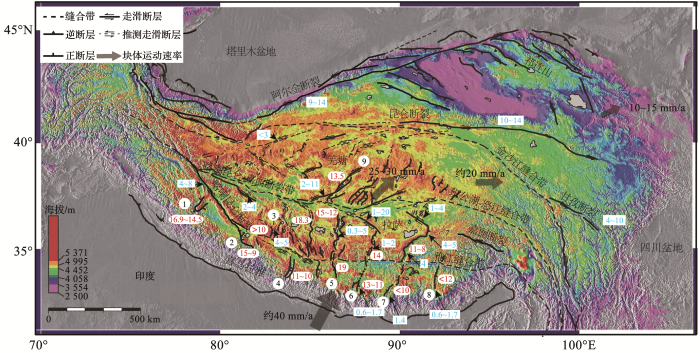
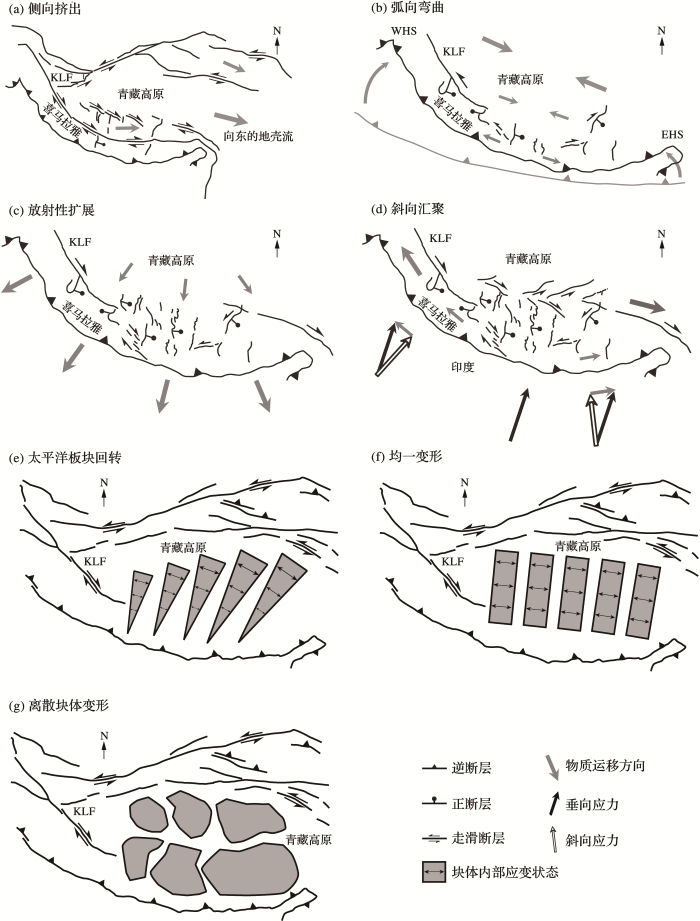
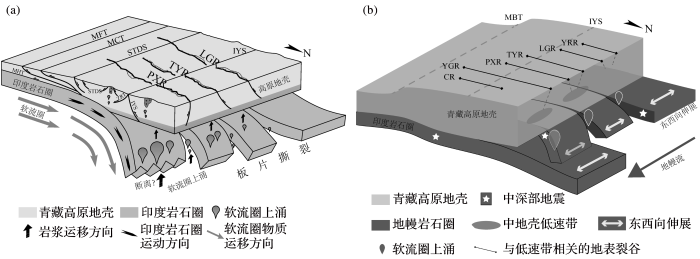
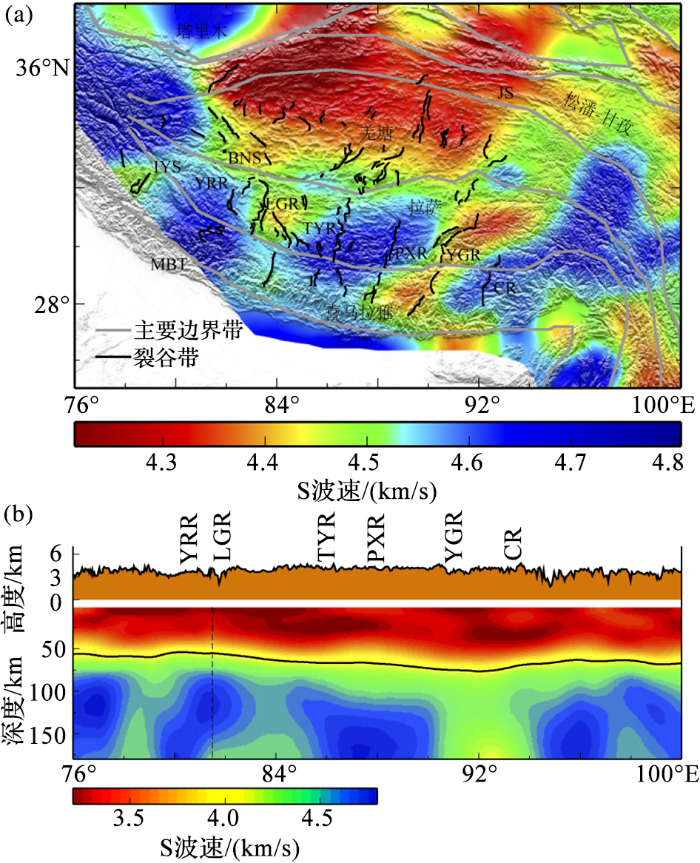
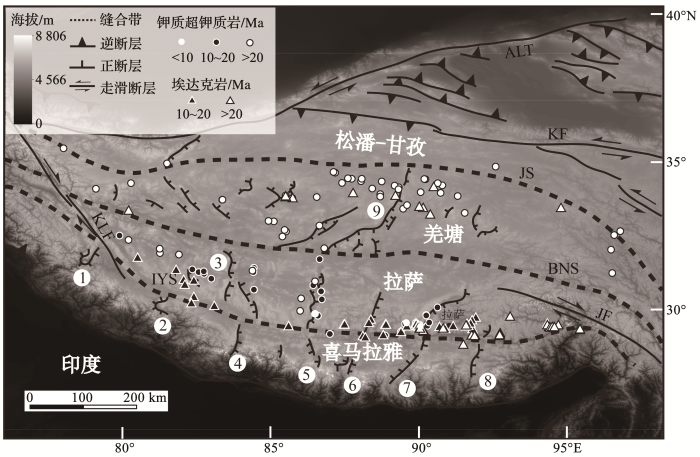
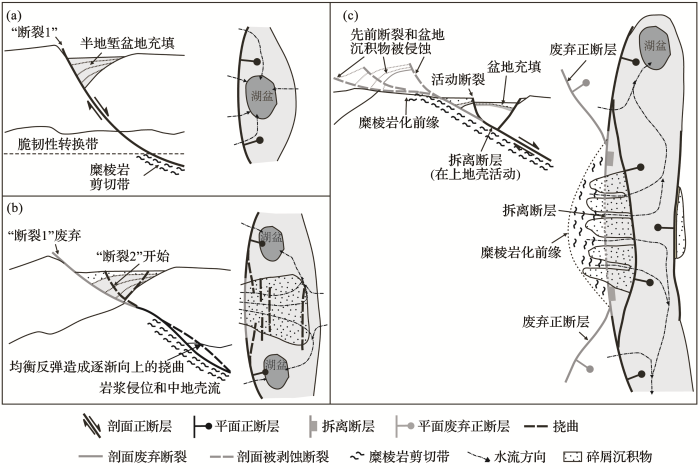


 甘公网安备62010202000687
甘公网安备62010202000687